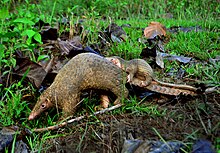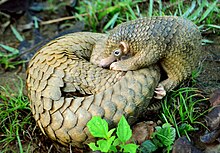
Pangolins, sometimes known as scaly anteaters, are mammals of the order Pholidota. The one extant family, the Manidae, has three genera: Manis, Phataginus, and Smutsia. Manis comprises four species found in Asia, while Phataginus and Smutsia include two species each, all found in sub-Saharan Africa. These species range in size from 30 to 100 cm. A number of extinct pangolin species are also known. In September 2023, nine species were reported.

The ground pangolin, also known as Temminck's pangolin, Cape pangolin or steppe pangolin is a species of pangolin from genus Smutsia of subfamily Smutsiinae the within family Manidae. It is one of four species of pangolins which can be found in Africa, and the only one in southern and eastern Africa. The animal was named for the Dutch zoologist Coenraad Jacob Temminck.

Manis ("spirit") is a genus of South Asian and East Asian pangolins, the Asiatic pangolins, from subfamily Maninae, within family Manidae.

Manidae ("spirits") is the only extant family of pangolins from superfamily Manoidea. This family comprises three genera, as well as extinct Fayum pangolin.

Siebenrockiella leytensis is a species of freshwater turtle endemic to the Philippines. It is classified as critically endangered. It is known as the Philippine forest turtle, the Philippine pond turtle, the Palawan turtle, or the Leyte pond turtle. Despite the latter common name, it does not occur in the island of Leyte but is instead native to the Palawan island group. It is locally known as bakoko in Cuyonon.

The Indian pangolin, also called thick-tailed pangolin and scaly anteater, is a pangolin native to the Indian subcontinent. Like other pangolins, it has large, overlapping scales on its body which act as armour. The colour of its scales varies depending on the colour of the earth in its surroundings. It can also curl itself into a ball as self-defence against predators such as the tiger. It is an insectivore feeding on ants and termites, digging them out of mounds and logs using its long claws, which are as long as its fore limbs. It is nocturnal and rests in deep burrows during the day.

The giant pangolin is a species of pangolins from genus Smutsia of subfamily Smutsiinae within the family Manidae. It is the largest living species of pangolins. Members of the species inhabit Africa with a range stretching along the equator from West Africa to Uganda. It subsists almost entirely on ants and termites.

The Sunda pangolin, also known as the Malayan or Javan pangolin, is a species of pangolin.

Eomanis is the earliest known true pangolin from extinct family Eomanidae within suborder Eupholidota. It lived during the Eocene in Europe. Eomanis fossils found in the Messel Pit in Germany are very similar in size and anatomy to living pangolins of the genus Manis, indicating that pangolins have remained largely unchanged in morphology and behavior for 50 million years. However, unlike modern pangolins, its tail and legs did not bear scales. According to the stomach contents of the excellently preserved Messel specimens, Eomanis’ diet consisted of both insects and plants.

The Palawan stink badger, pantot or tuldo in the Batak language, is a carnivoran of the western Philippines named for its resemblance to badgers, its powerful smell, and the largest island to which it is native, Palawan. Like all stink badgers, the Palawan stink badger was once thought to share a more recent common ancestor with badgers than with skunks. Recent genetic evidence, however, has led to their re-classification as one of the Mephitidae, the skunk family of mammals. It is the size of a large skunk or small badger, and uses its badger-like body to dig by night for invertebrates in open areas near patches of brush. While it lacks the whitish dorsal patches typical of its closest relatives, predators and hunters generally avoid the powerful noxious chemicals it can spray from the specialized anal glands characteristic of mephitids.

The Chinese pangolin is a pangolin native to the northern Indian subcontinent, northern parts of Southeast Asia and southern China. It has been listed as Critically Endangered on the IUCN Red List since 2014, as the wild population is estimated to have declined by more than 80% in three pangolin generations, equal to 21 years. It is threatened by poaching for the illegal wildlife trade.

The long-tailed pangolin, also called the African black-bellied pangolin or ipi, is a diurnal, arboreal pangolin species belonging to the family Manidae, in the order Pholidota. They feed on ants rather than termites. The common names for this species stem from physical characteristics, such as the extremely long tail or the dark hairs that cover the underside of their bodies and limbs. Pangolin comes from the Malay word pengguling, meaning “something that rolls up”.
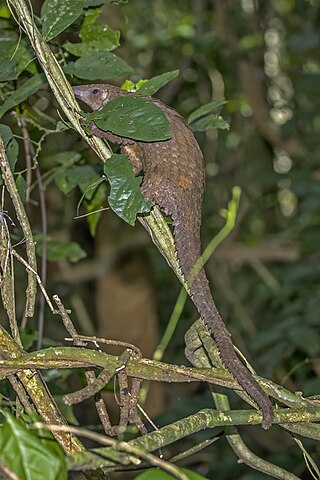
The tree pangolin is one of eight extant species of pangolins, and is native to equatorial Africa. Also known as the white-bellied pangolin or three-cusped pangolin, it is the most common of the African forest pangolins.
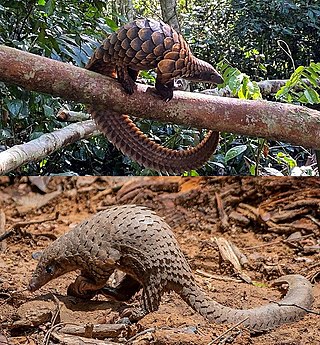
African tree pangolin (Phataginus) is a genus of African pangolins from subfamily small African pangolins (Phatagininae), within family Manidae. Its members are the more arboreal of the African pangolins.

African ground pangolin is a genus of pangolins from subfamily Smutsiinae within family Manidae. It was formerly considered a subgenus of genus Manis. Its members are the more terrestrial of the African pangolins. In past, this genus was also present in Europe.

The pangolin trade is the illegal poaching, trafficking, and sale of pangolins, parts of pangolins, or pangolin-derived products on the black market. Pangolins are believed to be the world's most trafficked mammal, accounting for as much as 20% of all illegal wildlife trade. According to the International Union for Conservation of Nature (IUCN), more than a million pangolins were poached in the decade prior to 2014.
Pangolin, sometimes known as a scaly anteater, is a mammal of the order Pholidota -one extant family, Manidae; more specifically:
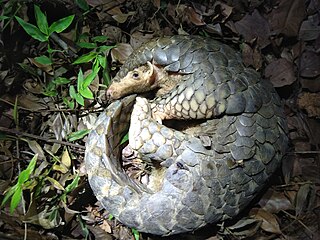
The Taiwanese pangolin, also known as the Formosan pangolin, is a subspecies of the Chinese pangolin that is native to Taiwan. Its population has largely declined over the past few decades, mainly due to the threat of poaching and illegal trading of their valuable scales and meat.
